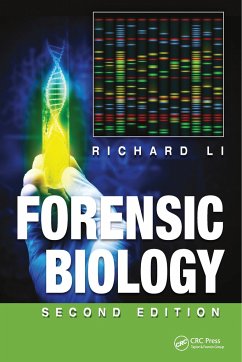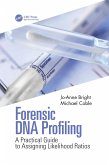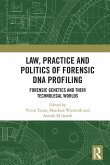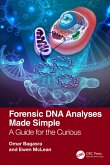Richard Li
Forensic Biology
Schade – dieser Artikel ist leider ausverkauft. Sobald wir wissen, ob und wann der Artikel wieder verfügbar ist, informieren wir Sie an dieser Stelle.
Richard Li
Forensic Biology
- Broschiertes Buch
- Merkliste
- Auf die Merkliste
- Bewerten Bewerten
- Teilen
- Produkt teilen
- Produkterinnerung
- Produkterinnerung
Focusing on forensic serology and forensic DNA analysis, this book introduces students to the methods and techniques utilized by forensic biology laboratories.
Andere Kunden interessierten sich auch für
![Forensic Biology Forensic Biology]() Richard Li (John Jay College of Criminal Justice, New York, New YorForensic Biology195,99 €
Richard Li (John Jay College of Criminal Justice, New York, New YorForensic Biology195,99 €![Forensic DNA Profiling Forensic DNA Profiling]() Jo-Anne BrightForensic DNA Profiling78,99 €
Jo-Anne BrightForensic DNA Profiling78,99 €![Law, Practice and Politics of Forensic DNA Profiling Law, Practice and Politics of Forensic DNA Profiling]() Law, Practice and Politics of Forensic DNA Profiling41,99 €
Law, Practice and Politics of Forensic DNA Profiling41,99 €![Handbook of Forensic Statistics Handbook of Forensic Statistics]() Handbook of Forensic Statistics78,99 €
Handbook of Forensic Statistics78,99 €![Forensic DNA Analyses Made Simple Forensic DNA Analyses Made Simple]() Omar BagasraForensic DNA Analyses Made Simple67,99 €
Omar BagasraForensic DNA Analyses Made Simple67,99 €![Forensic DNA Transfer Forensic DNA Transfer]() Jane Moira TaupinForensic DNA Transfer154,99 €
Jane Moira TaupinForensic DNA Transfer154,99 €![Forensic DNA Transfer Forensic DNA Transfer]() Jane Moira TaupinForensic DNA Transfer56,99 €
Jane Moira TaupinForensic DNA Transfer56,99 €-
-
Focusing on forensic serology and forensic DNA analysis, this book introduces students to the methods and techniques utilized by forensic biology laboratories.
Produktdetails
- Produktdetails
- Verlag: Taylor & Francis Ltd
- 2 ed
- Seitenzahl: 568
- Erscheinungstermin: 30. Juni 2021
- Englisch
- Abmessung: 396mm x 253mm x 40mm
- Gewicht: 1326g
- ISBN-13: 9781032098791
- ISBN-10: 1032098791
- Artikelnr.: 62149079
- Herstellerkennzeichnung
- Libri GmbH
- Europaallee 1
- 36244 Bad Hersfeld
- gpsr@libri.de
- Verlag: Taylor & Francis Ltd
- 2 ed
- Seitenzahl: 568
- Erscheinungstermin: 30. Juni 2021
- Englisch
- Abmessung: 396mm x 253mm x 40mm
- Gewicht: 1326g
- ISBN-13: 9781032098791
- ISBN-10: 1032098791
- Artikelnr.: 62149079
- Herstellerkennzeichnung
- Libri GmbH
- Europaallee 1
- 36244 Bad Hersfeld
- gpsr@libri.de
Richard Li
Biological Evidence. Crime Scene Investigation of Biological Evidence.
Crime Scene Bloodstain Pattern Analysis. Forensic Biology: A Subdiscipline
of Forensic Science. Sources of Biological Evidence. Basic Techniques in
Forensic Biology. Nucleic Acid Extraction. DNA Quantitation. Amplification
by Polymerase Chain Reaction. DNA Electrophoresis. Detection Methods.
Serology Concepts. Serology Techniques: Past, Current, and Future.
Identification of Biological Evidence. Identification of Blood. Species
Identification. Identification of Semen. Identification of Saliva.
Identification of Vaginal Secretions and Menstrual Blood. Identification of
Urine, Sweat, Fecal Matter, and Vomitus. Individualization of Biological
Evidence. Blood Group Typing and Protein Profiling. Variable Number Tandem
Repeat Profiling. Autosomal Short Tandem Repeat Profiling. Sex Chromosome
Haplotyping and Gender Identification. Single Nucleotide Polymorphism
Profiling. Mitochondrial DNA Profiling. Forensic Issues. Forensic DNA
Databases: Tools for Crime Investigations. Evaluation of the Strength of
Forensic DNA Profiling Results. Quality Assurance and Quality Control.
Crime Scene Bloodstain Pattern Analysis. Forensic Biology: A Subdiscipline
of Forensic Science. Sources of Biological Evidence. Basic Techniques in
Forensic Biology. Nucleic Acid Extraction. DNA Quantitation. Amplification
by Polymerase Chain Reaction. DNA Electrophoresis. Detection Methods.
Serology Concepts. Serology Techniques: Past, Current, and Future.
Identification of Biological Evidence. Identification of Blood. Species
Identification. Identification of Semen. Identification of Saliva.
Identification of Vaginal Secretions and Menstrual Blood. Identification of
Urine, Sweat, Fecal Matter, and Vomitus. Individualization of Biological
Evidence. Blood Group Typing and Protein Profiling. Variable Number Tandem
Repeat Profiling. Autosomal Short Tandem Repeat Profiling. Sex Chromosome
Haplotyping and Gender Identification. Single Nucleotide Polymorphism
Profiling. Mitochondrial DNA Profiling. Forensic Issues. Forensic DNA
Databases: Tools for Crime Investigations. Evaluation of the Strength of
Forensic DNA Profiling Results. Quality Assurance and Quality Control.
Biological Evidence. Crime Scene Investigation of Biological Evidence.
Crime Scene Bloodstain Pattern Analysis. Forensic Biology: A Subdiscipline
of Forensic Science. Sources of Biological Evidence. Basic Techniques in
Forensic Biology. Nucleic Acid Extraction. DNA Quantitation. Amplification
by Polymerase Chain Reaction. DNA Electrophoresis. Detection Methods.
Serology Concepts. Serology Techniques: Past, Current, and Future.
Identification of Biological Evidence. Identification of Blood. Species
Identification. Identification of Semen. Identification of Saliva.
Identification of Vaginal Secretions and Menstrual Blood. Identification of
Urine, Sweat, Fecal Matter, and Vomitus. Individualization of Biological
Evidence. Blood Group Typing and Protein Profiling. Variable Number Tandem
Repeat Profiling. Autosomal Short Tandem Repeat Profiling. Sex Chromosome
Haplotyping and Gender Identification. Single Nucleotide Polymorphism
Profiling. Mitochondrial DNA Profiling. Forensic Issues. Forensic DNA
Databases: Tools for Crime Investigations. Evaluation of the Strength of
Forensic DNA Profiling Results. Quality Assurance and Quality Control.
Crime Scene Bloodstain Pattern Analysis. Forensic Biology: A Subdiscipline
of Forensic Science. Sources of Biological Evidence. Basic Techniques in
Forensic Biology. Nucleic Acid Extraction. DNA Quantitation. Amplification
by Polymerase Chain Reaction. DNA Electrophoresis. Detection Methods.
Serology Concepts. Serology Techniques: Past, Current, and Future.
Identification of Biological Evidence. Identification of Blood. Species
Identification. Identification of Semen. Identification of Saliva.
Identification of Vaginal Secretions and Menstrual Blood. Identification of
Urine, Sweat, Fecal Matter, and Vomitus. Individualization of Biological
Evidence. Blood Group Typing and Protein Profiling. Variable Number Tandem
Repeat Profiling. Autosomal Short Tandem Repeat Profiling. Sex Chromosome
Haplotyping and Gender Identification. Single Nucleotide Polymorphism
Profiling. Mitochondrial DNA Profiling. Forensic Issues. Forensic DNA
Databases: Tools for Crime Investigations. Evaluation of the Strength of
Forensic DNA Profiling Results. Quality Assurance and Quality Control.








